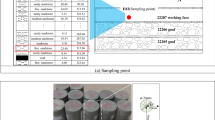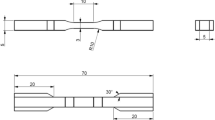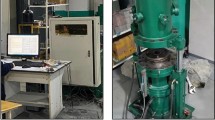Abstract
WHEN a rock specimen is compressed from an initial intact state to complete collapse, the failure locus can be traced out on a force–displacement diagram as shown by the solid line in Fig. 1a. Until recently, this curve was followed in experiments only to the point where the compressive strength was reached; the rock then disintegrated violently. This catastrophic failure is caused by the elastic unloading of the testing machine after the peak of the force-displacement curve and is not an intrinsic property of the rock. The elastic strain energy released by conventional “soft” testing machines exceeds the amount of energy required to break the rock and the excess energy is liberated in the form of kinetic energy. Uncontrollable failure can be avoided by the use of “stiff” testing machines which store very little strain energy1–6, or by closed loop servocontrolled testing machines which can reduce the load faster than the specimen breaks7–9.
This is a preview of subscription content, access via your institution
Access options
Subscribe to this journal
Receive 51 print issues and online access
$199.00 per year
only $3.90 per issue
Buy this article
- Purchase on Springer Link
- Instant access to full article PDF
Prices may be subject to local taxes which are calculated during checkout
Similar content being viewed by others
References
Barnard, P. R., Mag. Concrete Res., 16, 203 (1964).
Hughes, B. P., and Chapman, G. P., RILEM Bull., 30, 95 (1966).
Cook, N. G. W., and Hojem, J. P. M., S. Afric. Mech. Eng., 16, 89 (1966).
Bieniawski, Z. T., Intern. J. Rock Mech. Min. Sci., 4, 407 (1967).
Wawersik, W. R., and Fairhurst, C., Intern. J. Rock Mech. Min. Sci., 1, 561 (1970).
Wawersik, W. R., and Brace, W. F., Rock Mechanics (in the press).
Rummel, F., and Fairhurst, C., Rock Mechanics, 2, 189 (1970).
Hudson, J. A., Brown, E. T., and Fairhurst, C., Rock Mechanics (in the press).
Brown, E. T., Hudson, J. A., Hardy, M. P., and Fairhurst, C., Rock Mechanics (in the press).
Hardy, H. R., Quart. J. Colorado School of Mines, 54, 3–134 (1959).
Murrell, S. A. F., Bull. Inst. Mining and Metallurgy, 71, 7–353 (1962).
Wiild, B. L., The Time Dependent Behaviour of Rock. The Strength and Deformation Characteristics, MEG 514 (CSIR, Pretoria, 1966).
Scholz, C. H., J. Geophys. Res., 73, 3295 (1968).
Jaeger, J. C., and Cook, N. G. W., Fundamentals of Rock Mechanics (Methuen, London, 1969).
Bieniawski, Z. T., Rock Mechanics, 2, 123 (1970).
Author information
Authors and Affiliations
Rights and permissions
About this article
Cite this article
HUDSON, J. Effect of Time on the Mechanical Behaviour of Failed Rock. Nature 232, 185–186 (1971). https://doi.org/10.1038/232185a0
Received:
Issue Date:
DOI: https://doi.org/10.1038/232185a0
This article is cited by
-
Mechanism and Effect of Stress Level on the Generalized Relaxation Behavior of Tage Tuff Under Triaxial Compression
Rock Mechanics and Rock Engineering (2023)
-
Effect of time on the stress–strain behaviour of a single rock joint
Bulletin of Engineering Geology and the Environment (2005)
-
Degradation of polycarbonate sheeting on outdoor exposure. Relationship between changes in molecular weight and tensile properties
Matériaux et Constructions (1977)
-
Strength and complete stress-strain relationships for concrete tested in uniaxial compression under different test conditions
Matériaux et Constructions (1972)
Comments
By submitting a comment you agree to abide by our Terms and Community Guidelines. If you find something abusive or that does not comply with our terms or guidelines please flag it as inappropriate.



